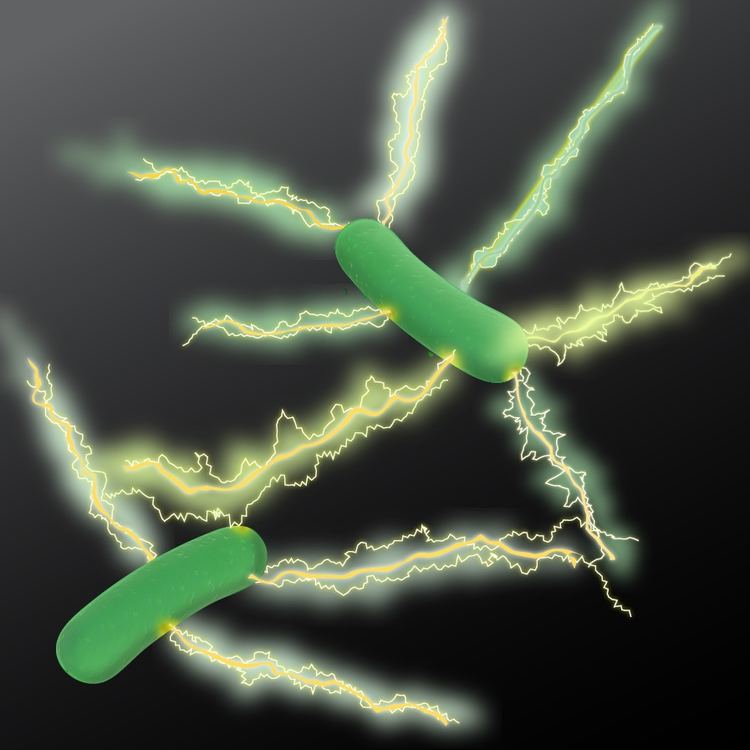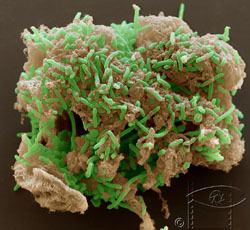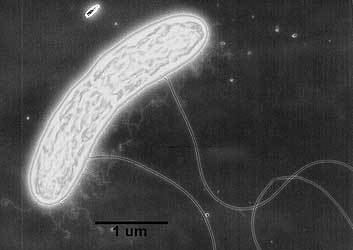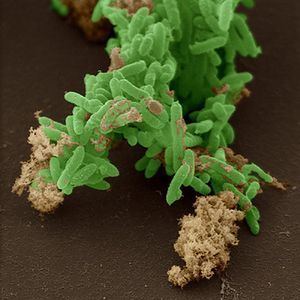Kingdom Bacteria Order Desulfuromonadales Scientific name Geobacter Rank Genus | Phylum Proteobacteria Family Geobacteraceae Higher classification Geobacteraceae | |
 | ||
Similar Geobacter sulfurreducens, Bacteria, Geobacter metallireducens, Shewanella, Shewanella oneidensis | ||
Geobacter the electricity producing bacteria michael mong
Geobacter is a genus of Proteobacteria. Geobacter species are anaerobic respiration bacterial species which have capabilities that make them useful in bioremediation. Geobacter was found to be the first organism with the ability to oxidize organic compounds and metals, including iron, radioactive metals, and petroleum compounds into environmentally benign carbon dioxide while using iron oxide or other available metals as electron acceptors. Geobacter species are also found to be able to respire upon a graphite electrode. They have been found in anaerobic conditions in soils and aquatic sediment.
Contents
- Geobacter the electricity producing bacteria michael mong
- E coli bacteria technology geobacter sulfurreducens biological fuel cells grow nanowires
- History
- Applications
- Fuel cell
- Biodegradation and bioremediation
- Popular culture
- References

E coli bacteria technology geobacter sulfurreducens biological fuel cells grow nanowires
History

Geobacter metallireducens was first isolated by Derek Lovley in 1987 in sand sediment from the Potomac River in Washington D.C. The first strain was deemed strain GS-15.
Applications

Geobacter's ability to consume oil-based pollutants and radioactive material with carbon dioxide as waste byproduct has been used in environmental clean-up for underground petroleum spills and for the precipitation of uranium out of groundwater. Geobacter metabolize the material by creating electrically conductive pili between itself and the food material.

Multiple Geobacter species cooperate in metabolizing a mixture of chemicals that neither could process alone. Provided with ethanol and sodium fumarate, G. metallireducens broke down the ethanol, generating an excess of electrons that were passed to G. sulfurreducens via "nanowires" grown between them, enabling G. sulfurreducens to break down the fumarate ions. The nanowires are made of proteins with metal-like conductivity.
Fuel cell
The production of electricity during this process led scientists to theorize that Geobacter could act as a living fuel cell that could convert biomass into electricity. Potential applications exist in the field of nanotechnology for the creation of microbial nanowires in very small circuits and electronic devices. The nanowires could be connected, creating a microscopic power grid.
Biodegradation and bioremediation
Microbial biodegradation of recalcitrant organic pollutants is of great environmental significance and involves intriguing novel biochemical reactions. In particular, hydrocarbons and halogenated compounds have long been doubted to be anaerobically degradable, but the isolation of hitherto unknown anaerobic hydrocarbon-degrading and reductively dehalogenating bacteria documented these processes in nature. Novel biochemical reactions were discovered, enabling the respective metabolic pathways, but progress in the molecular understanding of these bacteria was slowed by the absence of genetic systems for most of them. However, several complete genome sequences later became available for such bacteria. The genome of the hydrocarbon degrading and iron-reducing species G. metallireducens (accession nr. NC_007517) was determined in 2008. The genome revealed the presence of genes for reductive dehalogenases, suggesting a wide dehalogenating spectrum. Moreover, genome sequences provided insights into the evolution of reductive dehalogenation and differing strategies for niche adaptation.
Geobacter species are often the predominant organisms when extracellular electron transfer is an important bioremediation process in subsurface environments. Therefore, a systems biology approach to understanding and optimizing bioremediation with Geobacter species has been initiated with the ultimate goal of developing in silico models that can predict the growth and metabolism of Geobacter species under a diversity of subsurface conditions. The genomes of multiple Geobacter species have been sequenced. Detailed functional genomic/physiological studies on one species, G. sulfurreducens was conducted. Genome-based models of several Geobacter species that are able to predict physiological responses under different environmental conditions are available. Quantitative analysis of gene transcript levels during in situ uranium bioremediation demonstrated that it is possible to track in situ rates of metabolism and the in situ metabolic state of Geobacter in the subsurface.
Popular culture
Geobacter is used as a plot device in the first episode of the third season of ReGenesis. Geobacter has become an icon for teaching about microbial electrogenesis and microbial fuel cells and has appeared in educational kits that are available for students and hobbyists. The genus even has its own plush toy Geobacter is also used to generate electricity via electrode grid in Amazon,Peru.
